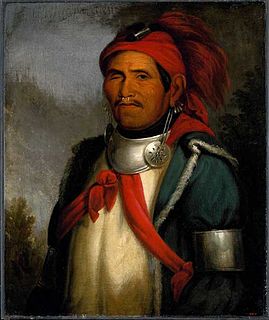 W
WThe Native American tribes in Virginia are the indigenous tribes who currently live or have historically lived in what is now the Commonwealth of Virginia in the United States of America.
 W
WThe Doeg were a Native American people who lived in Virginia. They spoke an Algonquian language and may have been a branch of the Nanticoke tribe, historically based on the Eastern Shore of Maryland. The Nanticoke considered the Algonquian Lenape as "grandfathers". The Doeg are known for a raid in July 1675 that contributed to colonists' uprising in Bacon's Rebellion.
 W
WThe Manahoac, also recorded as Mahock, were a small group of Siouan-language Native Americans in northern Virginia at the time of European contact. They numbered approximately 1,000 and lived primarily along the Rappahannock River west of modern Fredericksburg and the Fall Line, and east of the Blue Ridge Mountains. They united with the Monacan, the Occaneechi, the Saponi and the Tutelo. They disappeared from the historical record after 1728.
 W
WThe Mattawoman were a group of Native Americans living along the Western Shore of Maryland on the Chesapeake Bay at the time of English colonization. They lived along Mattawoman Creek in present-day Charles County, Maryland. They were also recorded in the early 17th century by explorer John Smith at Quantico Creek in Prince William County, Virginia. He called them Pamacocack.
 W
WThe Meherrin Nation is one of seven state-recognized nations of Native Americans in North Carolina. They reside in rural northeastern North Carolina, near the river of the same name on the Virginia-North Carolina border. Historically the Iroquoian-speaking tribe had lived in the Piedmont of Virginia but moved south in the early 18th century under pressure of English colonists' encroachment on their territory.
 W
WThe Nottoway are a Native American tribe in Virginia. Historically, the Nottoway spoke an Iroquoian language, Nottoway, and were related to other Iroquoian speakers.
 W
WThe Pamunkey Indian Tribe is one of 11 Virginia Indian tribes recognized by the Commonwealth of Virginia, and the state's first federally recognized tribe, receiving its status in January 2016. Six other Virginia tribes, the Chickahominy, the Eastern Chickahominy, the Upper Mattaponi, the Rappahannock, the Monacan, and the Nansemond, were similarly recognized through the passage of the Thomasina E. Jordan Indian Tribes of Virginia Federal Recognition Act of 2017 on January 12, 2018. The historical tribe was part of the Powhatan paramountcy, made up of Algonquian-speaking tribes. The Powhatan paramount chiefdom was made up of over 30 tribes, estimated to total about 10,000–15,000 people at the time the English arrived in 1607. The Pamunkey tribe made up about one-tenth to one-fifteenth of the total, as they numbered about 1,000 persons in 1607.
 W
WThe Paspahegh tribe were tributaries to the Powhatan paramount chiefdom, incorporated into the chiefdom around 1596 or 1597. The Paspahegh Indian tribe lived in present-day Charles City and James City counties, Virginia. The Powhatan tribes were a group of Native Americans who spoke a branch of Algonquian language.
 W
WThe Powhatan people; also spelled Powatan) may refer to any of the indigenous Algonquian people that are traditionally from eastern Virginia. All of the Powhatan groups descend from the Powhatan Confederacy. In some instances, The Powhatan may refer to one of the leaders of the people. This is most commonly the case in historical writings by the English. The Powhatans have also been known as Virginia Algonquians, as the Powhatan language is an eastern-Algonquian language, also known as Virginia Algonquian. It is estimated that there were about 14,000–21,000 Powhatan people in eastern Virginia, when the English colonized Jamestown in 1607.
 W
WThe Rappahannock are one of the eleven state-recognized Native American tribes in Virginia. They are made up of descendants of several small Algonquian-speaking tribes who merged in the 17th century. In January 2018, they were one of six Virginia tribes to gain federal recognition by the passage of the Thomasina E. Jordan Indian Tribes of Virginia Federal Recognition Act of 2017.
 W
WThe Shawnee are an Algonquian-speaking ethnic group indigenous to North America. In colonial times they were a semi-migratory Native American nation, primarily inhabiting areas of the Ohio Valley, extending from what became Ohio and Kentucky eastward to West Virginia, Virginia, Pennsylvania, and Western Maryland; south to Alabama and South Carolina; and westward to Indiana, and Illinois.
 W
WThe Tutelo were Native American people living above the Fall Line in present-day Virginia and West Virginia. They spoke a Siouan dialect of the Tutelo language thought to be similar to that of their neighbors, the Monacan and Manahoac nations. Under pressure from English settlers and Seneca Iroquois, they joined with other Virginia Siouan tribes in the late 17th century and became collectively known as the Tutelo-Saponi. By 1740, they had largely left Virginia and migrated north to seek protection from their former Iroquois opponents. They were adopted by the Cayuga tribe of New York in 1753.